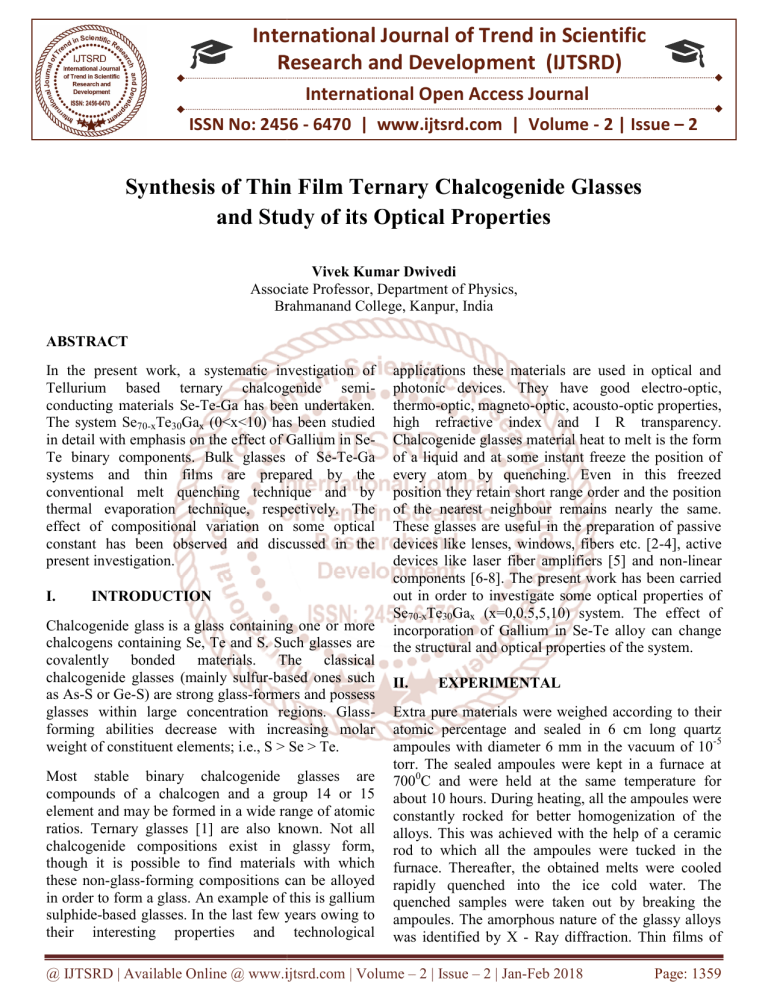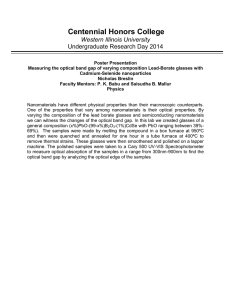
International Journal of Trend in Scientific
Research and Development (IJTSRD)
International Open Access Journal
ISSN No: 2456 - 6470 | www.ijtsrd.com | Volume - 2 | Issue – 2
Synthesis of Thin Fil
Film Ternary Chalcogenide Glasses
and Study of its Optical Properties
Vivek Kumar Dwivedi
Associate Professor, Department of Physics,
Brahmanand College
College, Kanpur, India
ABSTRACT
In the present work, a systematic investigation of
Tellurium based ternary chalcogenide semi
semiconducting materials Se-Te-Ga
Ga has been undertaken.
The system Se70-xTe30Gax (0<x<10)
10) has been studied
in detail with emphasis on the effect of Gallium in Se
SeTe binary components. Bulk glasses of Se
Se-Te-Ga
systems and thin films are prepared by the
conventional melt quenching technique and by
thermal evaporation technique, respectively. The
effect of compositional variation on some optical
constant has been observed and discussed in the
present investigation.
I.
INTRODUCTION
Chalcogenide glass is a glass containing one or more
chalcogens containing Se, Te and S. Such glasses are
covalently bonded materials. The classical
chalcogenide glasses (mainly sulfur-based
based ones such
as As-S or Ge-S) are strong glass-formers
formers and possess
glasses within large concentration regions. Glass
Glassforming abilities
ies decrease with increasing molar
weight of constituent elements; i.e., S > Se > Te.
Most stable binary chalcogenide glasses are
compounds of a chalcogen and a group 14 or 15
element and may be formed in a wide range of atomic
ratios. Ternary glasses [1] are also known. Not all
chalcogenide compositions exist in glassy form,
though it is possible to find materials with which
these non-glass-forming
forming compositions can be alloyed
in order to form a glass. An example of this is gallium
sulphide-based glasses. Inn the last few years owing to
their interesting properties and technological
applications these materials are used in optical and
photonic devices. They have good electro-optic,
electro
thermo-optic, magneto-optic,
optic, acousto-optic
acousto
properties,
high refractive index and
nd I R transparency.
Chalcogenide glasses material heat to melt is the form
of a liquid and at some instant freeze the position of
every atom by quenching. Even in this freezed
position they retain short range order and the position
of the nearest neighbourr remains nearly the same.
These glasses are useful in the preparation of passive
devices like lenses, windows, fibers etc. [2-4],
[2
active
devices like laser fiber amplifiers [5] and non-linear
non
components [6-8]. The present work has been carried
out in orderr to investigate some optical properties of
Se70-xTe30Gax (x=0,0.5,5,10) system. The effect of
incorporation of Gallium in Se-Te
Se
alloy can change
the structural and optical properties of the system.
II.
EXPERIMENTAL
Extra pure materials were weighed according
accordi to their
atomic percentage and sealed in 6 cm long quartz
ampoules with diameter 6 mm in the vacuum of 10-5
torr. The sealed ampoules were kept in a furnace at
7000C and were held at the same temperature for
about 10 hours. During heating, all the ampoules
ampou were
constantly rocked for better homogenization of the
alloys. This was achieved with the help of a ceramic
rod to which all the ampoules were tucked in the
furnace. Thereafter, the obtained melts were cooled
rapidly quenched into the ice cold water. The
quenched samples were taken out by breaking the
ampoules. The amorphous nature of the glassy alloys
was identified by X - Ray diffraction. Thin films of
o
@ IJTSRD | Available Online @ www.ijtsrd.com | Volume – 2 | Issue – 2 | Jan-Feb
Feb 2018
Page: 1359
International Journal of Trend in Scientific Research and Development (IJTSRD) ISSN: 2456-6470
glassy alloys of thickness (~300 nm) were prepared
by thermal evaporation technique in which substrate
was kept at room temperature at a base pressure of 104
torr using the molybdenum boat, the film was kept
inside the deposition chamber for 24 hours to achieve
the stable equilibrium [9]. The thickness of the film
was measured by a single crystal thickness monitor.
III.
RESULTS AND DISCUSSION
The value of optical absorption coefficient () as a
function of incident photon (hv) for deposited thin
films of Se-Te-Ga at room temperature is given in
table 1.The absorption coefficient () is obtained
using the relation
Absorption
Coefficient
()
=Optical
Density(OD)/Thickness(t)
Table 1 depicts that the value of absorption coefficient
() increases linearly with the increase in photo
energy of Se70-xTe30Gax .Absorption of light [10] by
amorphous solids depends on the energies of the
incident photon and on the optical band gap of the
material. Thus behavior may be represented by the
equation given h=B (h - Eg) as given in
literature[11],where B is a constant which depends on
the transition probability, hv is energy of incident
photon, Eg is optical band gap of the material, r is an
index which depends on the nature of transition [12]
where r = 1/2 and r = 2 for allowed direct transition
and indirect transition, respectively.
Table 1: Variation of Absorption coefficient () with
photon energy in a Se-Te-Ga thin films at room temperature.
S. No.
1.
2.
3.
4.
5.
6.
7.
8.
9.
10.
Photon
Energy
E (eV)
1.378
1.459
1.549
1.907
2.066
2.254
2.479
2.754
3.541
4.131
Absorption coefficient () in Cm4
Se70Te30Ga0
Se69.5Te30Ga0.5
Se65Te30Ga5
Se60Te30Ga10
16555.656
16555.656
15000.00
23555.656
39888.989
63222.232
80333.433
111111.231
122777.878
227777.878
3988.889
3988.889
4766.667
24333.333
39888.889
57800.000
71000.000
111111.111
147111.111
266666.667
8777.778
8877.778
7222.222
7222.222
16555.556
30555.556
43000.000
57000.000
89666.667
227777.778
3988.989
4766.767
18888.989
29122.322
50877.878
74788.889
111111.111
173333.333
266666.667
The present system obeys the rule of indirect transition and the relation between optical gap, optical coefficient
() and the energy h of the incident photon is given by (h)1/2 =A(h - Eg) where obeys - Urbach relation
[13] = exp [A(h - h0 )]/kT where A is a constant of the order of unity, 0 is the constant corresponding to
the lowest excitonic frequency.
The variation of (h)1/2 with photon energy h for Se-Te-Ga films is given in table 3. The calculated values of
Eg are given in table 2. It is evident from the table that the value of optical band (Eg) increases from 1.25 to
1.33 with increasing Ga content. The increase in the Eg with increasing Ga may be due to increase in grain size,
the reduction in the disorder and decrease in density of defect states.
Table 2: Optical parameter Se-Te-Ga thin film at 700 nm at RT
X
Eg (eV)
(Cm-1) (104) N
k (10-3)
r'
r"
R%
T%
0
0.5
5
10
1.51
1.25
1.33
1.27
0.70
0.38
1.16
1.16
0.39
0.21
0.65
0.65
4.07
6.63
27.86
7.08
0.002
0.001
0.006
0.003
15.63
29.16
75.62
31.25
65.62
70.62
58.33
64.16
2.01
2.57
5.27
2.66
@ IJTSRD | Available Online @ www.ijtsrd.com | Volume – 2 | Issue – 2 | Jan-Feb 2018
Page: 1360
International Journal of Trend in Scientific Research and Development (IJTSRD) ISSN: 2456-6470
Table-3: Variation of ( h)1/2 with photon energy in a Se-Te-Ga thin films at Room Temperature.
S. No.
1.
2.
3.
4.
5.
6.
7.
8.
9.
10.
11.
12.
13.
14.
Photon
Absorption coefficient () in Cm4
Energy E Se75In25 Pb0
Se75In21 Pb4
Se75In19 Pb6
(eV)
1.377
146.338
103.477
N/A
1.441
150.581
106.477
75.290
1.511
147.250
98.167
85.015
1.588
124.172
87.803
101.386
1.674
111.310
82.966
143.701
1.770
207.351
108.906
184.659
1.877
283.382
179.227
237.095
1.998
374.392
258.032
334.867
2.136
443.382
322.608
427.898
2.294
527.629
392.666
527.629
2.478
580.761
478.404
649.311
2.693
631.849
560.250
760.395
2.950
948.379
948.379
1029.579
3.261
-
Se75In15 Pb10
73.169
75.290
85.015
113.353
143.701
210.896
283.382
355.180
416.485
527.629
620.860
694.142
1029.579
-
The value of Eg decreases from 1.33 to 1.27 with increasing Ga concentration in Se 70-xTe30Gax sample, since
the optical absorption depends on the short range order in the amorphous state and defects associated with it.
The decrease in the optical band gap in the present system may be due to reduction of the amount of disorder in
the system and increase in the density of defect state which is attributed to the shift in Fermi level whose
position is determined by the distribution of electrons over the localized states.The values of the variation of
(h)1/2 with photon energy (hv) for Se70-xTe30Gax films are given in the table 3.
The variation of reflectance (R) in percentage for the present system of Se-Te-Ga is shown in table 4. The table
shows that the reflectance (R) increases with the increase in wavelength. Similarly, the transmittance (T) has
also been shown for Se-Te-Ga in table 3. It is evident from the table that the percentage in the transmission
increases with respect to wavelength. It is clear from the table that the value of the transmission starts
decreasing after about 600 nm.
Table 4: Variation of reflection (R) in % with wave length
in a Se70-x Te30 Gax thin films at room temperature.
S. No.
1.
2.
3.
4.
5.
6.
7.
Wave
Reflection (R) in %
length in Se-Te-Ga
Se-Te-Ga
nm
900
88.500
62.500
800
71.833
54.583
700
15.625
29.167
600
46.875
14.583
500
31.667
32.500
400
30.208
31.250
300
28.333
22.917
Se-Te-Ga
Se-Te-Ga
31.250
60.417
75.625
30.208
41.667
36.458
29.167
28.125
13.750
31.250
41.667
28.125
31.667
22.917
@ IJTSRD | Available Online @ www.ijtsrd.com | Volume – 2 | Issue – 2 | Jan-Feb 2018
Page: 1361
International Journal of Trend in Scientific Research and Development (IJTSRD) ISSN: 2456-6470
S. No.
1.
2.
3.
4.
5.
6.
7.
Table-5: Variation of Transmission (T) in % with wave length
in a Se-Te-Ga thin films at Room Temperature.
Wave
Transmission (T) in %
length in Se-Te-Ga
Se-Te-Ga
Se-Te-Ga
Se-Te-Ga
nm
900
40.000
56.250
75.000
82.500
800
44.792
61.458
78.125
85.938
700
65.625
70.625
58.333
64.167
600
14.583
48.958
19.792
21.771
500
2.083
15.625
3.125
3.438
400
3.125
0.208
0.229
300
0.208
-
The refractive index (n) and extinction coefficient (k)
have been calculated by using the theory of
reflectivity of light for the above sample discussed.
According to this theory, the reflectance of light from
a this film can be expressed in terms of fresnel's
coefficient. The reflectivity [14-15] on a interface can
be given by-R=[(n-1)2 +k2]/[(n+1) 2 + k2and =4πK/
3. 3. Ovshinsky, S.R., Jpn. J. Appl. Phys., Vol. 43,
p. 4695 (2004).
The optical investigations shows that the optical band
gap increases upto 4% of Ga concentration in Se-TeGa, with further increase of Ga content the optical
band gap decreases in the present system.
6. N.Dixit and R.Vijaya, SPIE-The International
society for Optical Engineering, 4417 (2001) 477.
CONCLUSION
8. J.M.Herbold,
F.O.Leday,
F.W.Wise,
S.S.Sanghera, I.D.Agarwal and B.G.Aitken, SPIEThe International society for Optical Engineering,
5601 (2003) 143.
From the reflectance and transmittance studies of the
film of Se-Te-Ga, it may be concluded that the
refractive index (n) decreases, while the value of the
extinction coefficient k increases with photon energy.
The increase in the optical band gap with increasing
Ga content may be due to the increase in the grain
size, the reduction in the disorder and decrease in the
density of defect states. The value of optical band gap
(Eg) decreases at higher Ga concentration. The
decrease in the optical band gap in the present system
may be due to reduction in the amount of disorder in
the system and increase in the density of defect states.
4. Adler, D. et al., J. Appl. Phys., Vol. 51, p.
3289(1980)
5. T. Schweitzer, F. Goutaland, E. Martins,
D.W.Hewak and W.S. Brocklesby, Journal of
Optical Society of America B (optical physics),
18(10) (2001) 1436.
7. Ogusk, J.Yamasaki, S.Maeda, M. Kitao and M.
Minata, Optics Letters, 29(3) (2004) 265.
9. M. Abkowitz, G.M.T.Foley, J.M Morkovics and
A.C. Palumbo, AIP Conference Proceedings, 120
(1984) 117.
10. N.F. Mott and E.A. Davis, Electronic Process in
Non-Crystalline Materials (Clarendon, Oxford,
1979) 428.
11. S. Hsaegawa, S. Yazaki and Slinuzuol, Solid State
Commun., 26 (1978) 4070.
12. R.A. Smith, Philos. Mag. 2 (1953) 81.
REFERENCES
1. M.C. Flemings, B. Ilschner, E.J. Kramer, S.
Mahajan, K.H. Jurgen Buschow and R.W. Cahn,
Encyclopedia of Materials: Science and
Technology, Elsevier Science Ltd (2001).
2. 2. Vezzoli, G. C., Walsh, P. J., Doremus, L. W.,
J. Non-Cryst. Solids, Vol. 18, p. 333(1975).
13. F. Urbach, Physics Rev., 92 (1953) 1324.
14. L.S. Miller, A.J. Walder, P. Lensell and A.
Blundell, Thin Solid Films, 165 (1985) 11.
15. J.P. Borgogro, B. Lazarides and E. Pelletier, Appl.
Optics, 21 (1982) 4020.
@ IJTSRD | Available Online @ www.ijtsrd.com | Volume – 2 | Issue – 2 | Jan-Feb 2018
Page: 1362





